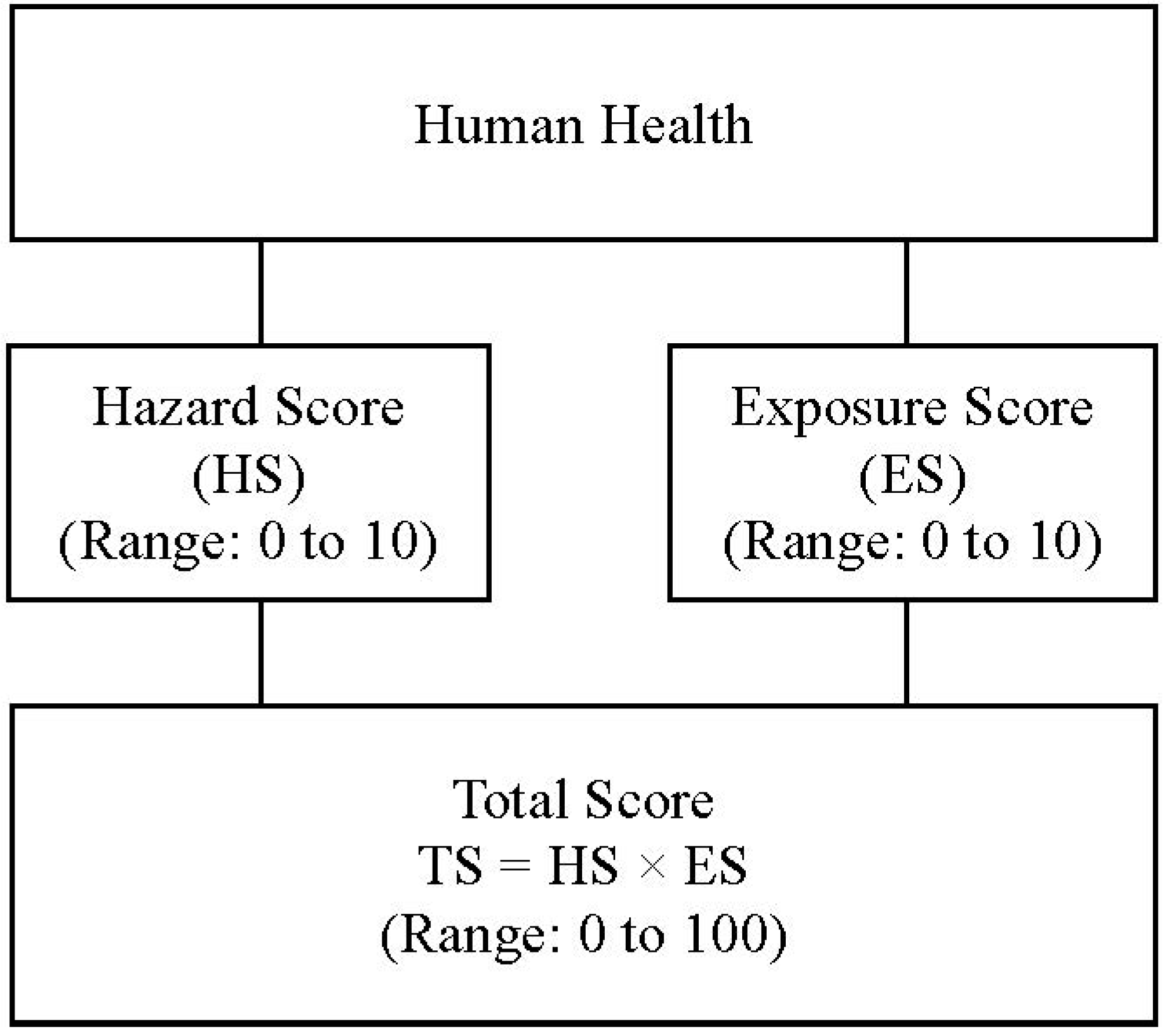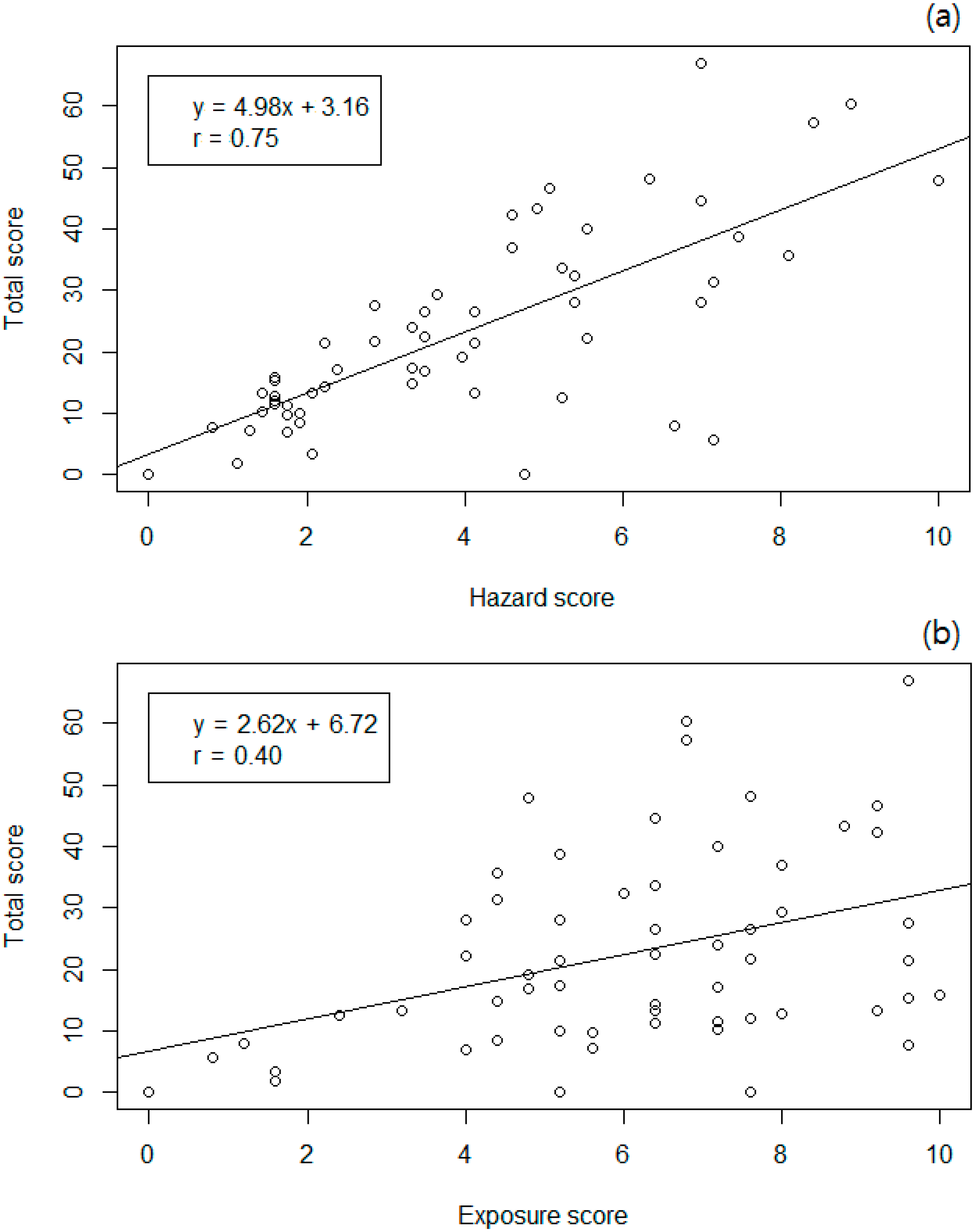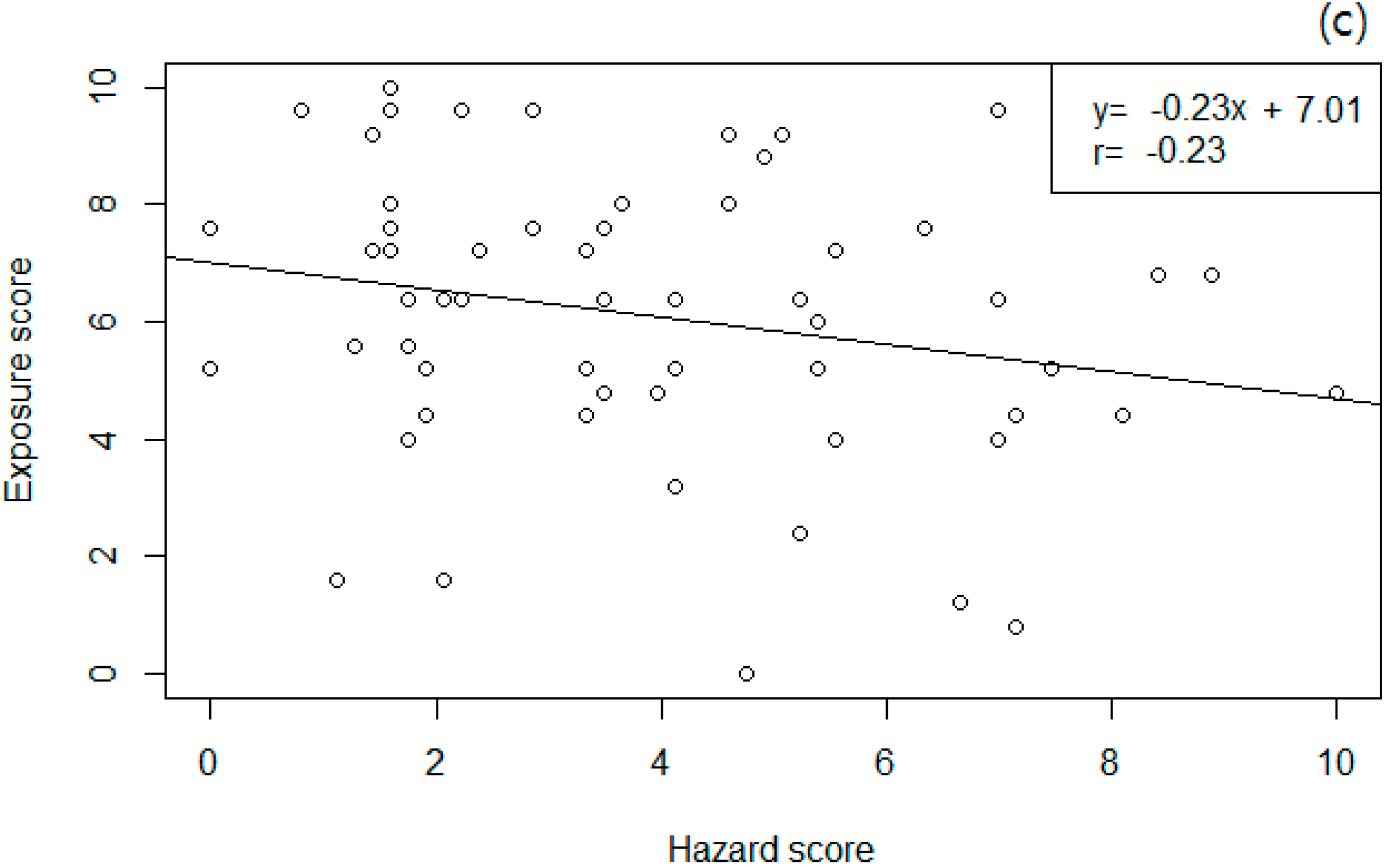A Chemical Risk Ranking and Scoring Method for the Selection of Harmful Substances to be Specially Controlled in Occupational Environments
Abstract
:1. Introduction
2. Methods
2.1. Chemical Risk Ranking and Scoring (CRIRS) Method
| Category | Euram | Crirs |
|---|---|---|
| Hazard indicators | Carcinogenicity Genetic toxicity Reproductive toxicity Respiratory sensitization Repeated dose toxicity Acute toxicity Irritation Skin sensitization | Acute toxicity (oral, dermal) |
| Acute toxicity (oral, dermal) | ||
| Irritation (skin, eyes) | ||
| Sensitization (skin, respiratory) | ||
| Aspiration hazard | ||
| Germ cell mutagenicity | ||
| Reproductive toxicity | ||
| Carcinogenicity | ||
| Target organ toxicity (repeated) | ||
| Exposure indicator | Emission Distribution | Handling volume |
| The number of Workers | ||
| The number of workplaces | ||
| Volatility/Dustiness | ||
| Measured exposure | ||
| Scoring method | Multiplying hazard and exposure scores that are normalized up to 10 | Multiplying hazard and exposure scores that are normalized up to 10 |

- HVi: the hazard/exposure indicator value of indicator I;
- HVmin: the minimum value for HVi;
- HVmax: the maximum value for HVi.
2.2. Hazard Indicator Scoring
| Term | Hazard Characteristics | Scoring by Hazard Class | |||||||
|---|---|---|---|---|---|---|---|---|---|
| Class 1 | Class 2 | Class 3 | Class 4 | No Data | Not Classified | Not Applicable | |||
| 1A | 1B | ||||||||
| T1 | Acute toxicity (oral, dermal) | 6 | 4 | 2 | 1 | 6 | 0 | 0 | |
| T2 | Acute toxicity (inhalation) | 5 | 3 | 2 | 1 | 5 | 0 | 0 | |
| T3 | Irritation (skin, eyes) | 6 | 4 | - | - | 6 | 0 | 0 | |
| T4 | Sensitization (skin, respiratory) | 9 | - | - | - | 9 | 0 | 0 | |
| T5 | Aspiration hazard | 5 | 3 | - | - | 5 | 0 | 0 | |
| T6 | Germ cell mutagenicity | 20 | 16 | 12 | - | - | 20 | 0 | 0 |
| T7 | Reproductive toxicity | 20 | 16 | 12 | - | - | 20 | 0 | 0 |
| T8 | Carcinogenicity | 20 | 16 | 12 | - | - | 20 | 0 | 0 |
| T9 | Target organ toxicity (repeated) | 9 | 7 | - | - | 9 | 0 | 0 | |
2.3. Exposure Indicator Scoring
| Term | Exposure Indicator | Classification Criteria | |||||
|---|---|---|---|---|---|---|---|
| Class 1 | Class 2 | Class 3 | Class 4 | Class 5 | |||
| E1 | Handling volume (ton/year) | >1000 | 10–1000 | 1–10 | 0.1–1 | <0.1 | |
| Circulation (ton/year) | >1000 | 10–1000 | 1–10 | 0.1–1 | <0.1 | ||
| E2 | Worker numbers (No.) | >300 | 100–300 | 50–100 | 5–50 | <5 | |
| E3 | Workplace numbers (No.) | >300 | 100–300 | 50–100 | 5–50 | <5 | |
| E4 | Volatility/Dustiness | Liquid/Gas (boiling point, °C) | <50 | 50–150 | >150 | - | - |
| Solid (as per ACGIH guidelines) | To have V, IFV, H, R | Powders or crystalline | Pellet-like, non-friable solids etc. | - | - | ||
| E5 | Measured exposure | Liquid/Gas (ppm) | >500 | 50–500 | 5–50 | 0.5–5 | <0.5 |
| Solid (mg/m3) | >10 | 1–10 | 0.1–1 | 0.01–0.1 | |||
| Term | Exposure Indicator | Scoring | ||||||
|---|---|---|---|---|---|---|---|---|
| Class 1 | Class 2 | Class 3 | Class 4 | Class 5 | Not Classified | |||
| E1 | Handling volume (replaced with circulation if data were missing) | 30 | 24 | 18 | 12 | 6 | 0 | |
| E2 | Worker numbers | 10 | 8 | 6 | 4 | 2 | 0 | |
| E3 | Workplace numbers | 10 | 8 | 6 | 4 | 2 | 0 | |
| E4 | Volatility/Dustiness | Liquid/Gas | 10 | 8 | 6 | - | - | 0 |
| Solid | 10 | 8 | 6 | - | - | 0 | ||
| E5 | Measured exposure | 40 | 32 | 24 | 16 | 8 | 0 | |
3. Results and Discussion
3.1. Evaluation of the Priority Setting
| Chemicals | CAS No. | Hazard Score | Exposure Score | Total Score |
|---|---|---|---|---|
| Styrene | 100-42-5 | 6.98 | 9.60 | 67.05 |
| Acrylamide | 79-06-1 | 8.89 | 6.80 | 60.44 |
| Acrylonitrile | 107-13-1 | 8.41 | 6.80 | 57.21 |
| Cyclohexanone | 108-94-1 | 6.35 | 7.60 | 48.25 |
| Ethyleneimine | 151-56-4 | 10.00 | 4.80 | 48.00 |
| Stoddard solvents | 8052-41-3 | 5.08 | 9.20 | 46.73 |
| Dimethyl sulfate | 77-78-1 | 6.98 | 6.40 | 44.70 |
| Perchloroethylene | 127-18-4 | 4.92 | 8.80 | 43.30 |
| Dimethylformamide | 68-12-2 | 4.60 | 9.20 | 42.35 |
| Ethyl acrylate | 140-88-3 | 5.56 | 7.20 | 40.00 |
3.2. Correlation Analysis of Individual Indicators and Total Score
| Indicator | r | |
|---|---|---|
| r1 | r2 | |
| CMR | 0.641 * | 0.911 * |
| Other toxicity | 0.603 * | 0.725 * |
| Handling volume | 0.421 * | 0.855 * |
| Distribution | 0.305 * | 0.874 * |
| Measured exposure | 0.160 | 0.580 * |


| Term | CMR | Other Toxicity | Handling Volume | Distribution | Measured Exposure |
|---|---|---|---|---|---|
| CMR | 1.000 | ||||
| Other toxicity | 0.375 * | 1.000 | |||
| Handling volume | −0.204 | 0.035 | 1.000 | ||
| Distribution | −0.240 | −0.135 | 0.613 * | 1.000 | |
| Measured exposure | −0.146 | −0.140 | 0.256 * | 0.355 * | 1.000 |
4. Conclusions
Acknowledgments
Author Contributions
Conflicts of Interest
References
- Hansen, B.G.; van Haelst, A.G.; van Leeuwen, K.; van der Zandt, P. Priority setting for existing chemicals: European Union risk ranking method. Environ. Toxicol. Chem. 1999, 18, 772–779. [Google Scholar] [CrossRef]
- Working Paper, Strengthen the Prevention of Occupational Diseases; Ministry of Economics and Labor (MOEL): Seoul, Korea, 2012; p. 815.
- Davis, G.A.; Swanson, M.B.; Jones, S. Comparative Evaluation of Chemical Ranking and Scoring Methodologies; University of Tennessee Center for Clean Products and Clean Technologies: Knoxville, TN, USA, 1994. [Google Scholar]
- Swanson, M.B.; Socha, S.A. Chemical Ranking and Scoring: Guidelines for Relative Assessments of Chemical; Swanson, M.B., Socha, S.A., Eds.; SETAC Press: New York, NY, USA, 1997; pp. 11–16. [Google Scholar]
- Swanson, M.B.; Davis, G.A.; Kincaid, L.E.; Schultz, T.W.; Bartmess, J.E.; Jones, S.L.; George, E.L. A screening method for ranking and scoring chemicals by potential human health and environmental impacts. Environ. Toxicol. Chem. 1997, 16, 372–383. [Google Scholar] [CrossRef]
- Yang, J.S.; Lim, C.H.; Park, S.Y. A study on the priority for the Hazard and Risk Evaluation of Chemicals (HREC) according to the Industrial Safety and Health Act (ISHA). J. Korean Soc. Occup. Environ. Hyg. 2012, 22, 73–81. [Google Scholar]
- Kim, Y.-S.; Lee, Y.-J.; Park, H.-S.; Lim, Y.-W.; Shin, D.-C. Comparative risk analysis for priority ranking of environmental problem. Environ. Health Toxicol. 2002, 17, 285–298. [Google Scholar]
- Choi, S.P.; Park, H.S.; Lee, D.S.; Shin, Y.S.; Kim, Y.S.; Shin, D.C. Development of CRS-Korea II and its application to setting the priority of toxic chemicals for local provinces. J. Environ. Toxicol. 2005, 20, 311–325. [Google Scholar]
- Park, H.S.; Kim, Y.S.; Lee, D.S.; Shin, Y.-S.; Choi, S.P.; Park, S.E.; Kim, M.H.; Yang, J.Y.; Shin, D.C. Development of Korean Chemical Ranking and Scoring System (CRS-Korea) and its application to prioritizing national toxic chemicals. J. Environ. Toxicol. 2005, 20, 109–121. [Google Scholar]
- The ART substance selection & guideline. In Environment Canada; European Commission: Brussels, Belgium, 1994.
- Jeong, S.-W.; An, Y.-J. Construction of a chemical ranking system of soil pollution substances for screening of priority soil contaminants in Korea. Environ. Monit. Assess. 2012, 184, 2193–2204. [Google Scholar] [CrossRef] [PubMed]
- Cousins, A.P.; Brorstrȍm-Lundèn, E.; Hedlund, B. Prioritizing organic chemicals for long-term air monitoring by using empirical monitoring data-application to data from the Swedich screening program. Environ. Monit. Assess. 2012, 184, 4647–4654. [Google Scholar] [CrossRef] [PubMed]
- Liu, J.; Tang, C.; Fan, D.; Wang, L.; Zhou, L.; Shi, L. Ranking and screening hazardous chemicals for human health in southeast China. Organic. Chem. Curr. Res. 2014, 3. [Google Scholar] [CrossRef]
- Park, S.H. A study on the priority for the hazard and risk evaluation of chemicals: 2. In Korea Occupational Safety and Health Agency; Korea Occupational Safety and Health Agency: Ulsan, Korea, 2011. [Google Scholar]
- Health standard. In Regulation 420; Ministry Of Employment and Labor: Sejong-si, Korea, 2013.
- Choi, S.J.; Phee, Y.G.; Kim, S.B.; Kim, W. A comparative legal study of Germany, the United Kingdom, Japan and Korea for the regulations on special management materials. J. Korean Soc. Occup. Environ. Hyg. 2013, 23, 137–147. [Google Scholar]
- Risk Classification Guidelines of Chemicals; Korea Occupational Safety and Health Agency: Ulsan, Korea, 2012.
- European Chemical Agency. C&L Inventory Database. Available online: http://echa.europa.eu/web/guest/information-on-chemicals/cl-inventory-database (accessed on 30 October 2013).
- International Agency for Research on Cancer. Agents Classified by the IARC Monographs. Available online: http://monographs.iarc.fr/ENG/Classification/index.php (accessed on 30 October 2013).
- National Toxicology Program. 12th Report on Carcinogens. Available online: http://ntp.niehs.nih.gov/ntp/roc/twelfth/addendum.pdf (accessed on 28 January 2014).
- ACGIH. 2013 TLVs® and BEIs®: Threshold limit values for chemical substances and physical agents. In Proceedings of the American Conference of Governmental Industrial Hygienists, Cincinnati, OH, USA; 2013. [Google Scholar]
- OSHA. Permissible Exposure Limits (PELs). Available online: https://www.osha.gov/dsg/topics/pel/ (accessed on 30 October 2013).
- Kim, K.Y. Classification of hazardous chemicals in conformity to the Globally Harmonized System and authorizing MSDS using GHS classification. In OSHRI, Occupational Safety and Health Research Institute; Korea Occupational Safety & Health Agency: Ulsan, Korea, 2012. [Google Scholar]
- Risk Assessment Guidelines of Chemicals; Department of Occupational Environment, Korea Occupational Safety & Health Agency: Ulsan, Korea, 2012. Available online: http://www.kosha.or.kr/www/cmsTiles.do?url=/cms/board/board/Board.jsp?communityKey=B0676&menuId=5286 (accessed on 14 February 2014).
- Kim, Y.-S.; Park, H.-S.; Lee, D.-S.; Shin, D.-C. Comparisons of chemical ranking and scoring methods. J. Environ. Toxicol. 2003, 18, 183–191. [Google Scholar]
- Chemical Hazard Risk Management Manual; Korea Occupational Safety & Health Agency: Ulsan, Korea, 2012.
- COSHH Essentials—Easy Steps to Control Chemicals. Available online: http://www.coshhessentials.org.uk (accessed on 26 January 2014).
- Indoor Air Quality: Organic Pollutants; World Health Organization (WHO): Geneva, Switzerland, 1989.
- Directive 2004/42/CE of the European Parliament and of the Council of 21 April 2004 on the Limitation of Emissions of Volatile Organic Compounds due to the Use of Organic Solvents in Certain Paints and Varnishes and Vehicle Refinishing Products and Amending Directive 1999/13/EC. Available online: http://eur-lex.europa.eu/LexUriServ/LexUriServ.do?uri=CELEX:32004L0042:en:NOT (accessed on 5 February 2014).
- American Conference of Governmental Industrial Hygienists (ACGIH). Documentation of the Threshold Limit Values and Biological Exposure Indices; ACGIH: Cincinnati, OH, USA, 2013. [Google Scholar]
- Davis, G.A.; George, E.L. Chemical Hazard Evaluation for Management Strategies: A Method for Ranking and Scoring Chemicals by Potential Human Health and Environmental Impacts, Risk Reduction Engineering Laboratory; Office of Research and Development, U.S. Environmental Protection Agency (EPA): Washington, DC, USA, 1994. [Google Scholar]
- Snyder, E.M.; Snyder, S.A.; Giesy, J.P.; Blonde, S.A.; Hurlburt, G.K.; Summer, C.L.; Mitchell, R.R.; Bush, D.M. SCRAM: A scoring and ranking system for persistent, bioaccumulative, and toxic substances for the North American Great Lakes. Environ. Sci. Pollut. R. 2000, 7, 176–184. [Google Scholar] [CrossRef]
- Chemical Screening Report for the RCRA PBT List Docket. U.S. EPA: Washington, DC, USA, 1998.
© 2014 by the authors; licensee MDPI, Basel, Switzerland. This article is an open access article distributed under the terms and conditions of the Creative Commons Attribution license (http://creativecommons.org/licenses/by/4.0/).
Share and Cite
Shin, S.; Moon, H.-I.; Lee, K.S.; Hong, M.K.; Byeon, S.-H. A Chemical Risk Ranking and Scoring Method for the Selection of Harmful Substances to be Specially Controlled in Occupational Environments. Int. J. Environ. Res. Public Health 2014, 11, 12001-12014. https://doi.org/10.3390/ijerph111112001
Shin S, Moon H-I, Lee KS, Hong MK, Byeon S-H. A Chemical Risk Ranking and Scoring Method for the Selection of Harmful Substances to be Specially Controlled in Occupational Environments. International Journal of Environmental Research and Public Health. 2014; 11(11):12001-12014. https://doi.org/10.3390/ijerph111112001
Chicago/Turabian StyleShin, Saemi, Hyung-Il Moon, Kwon Seob Lee, Mun Ki Hong, and Sang-Hoon Byeon. 2014. "A Chemical Risk Ranking and Scoring Method for the Selection of Harmful Substances to be Specially Controlled in Occupational Environments" International Journal of Environmental Research and Public Health 11, no. 11: 12001-12014. https://doi.org/10.3390/ijerph111112001
APA StyleShin, S., Moon, H.-I., Lee, K. S., Hong, M. K., & Byeon, S.-H. (2014). A Chemical Risk Ranking and Scoring Method for the Selection of Harmful Substances to be Specially Controlled in Occupational Environments. International Journal of Environmental Research and Public Health, 11(11), 12001-12014. https://doi.org/10.3390/ijerph111112001





